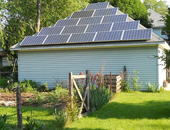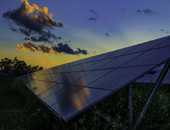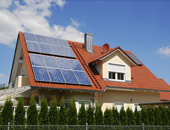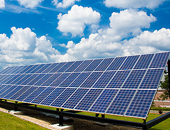Not all solar installation industries in India are producing Equal energy. The efficiency of the solar system performance is based on so many factors like the efficient technology, quality, durability of Solar Panel, Solar Inverter, MPPT and Battery.
A solar panel’s efficiency (how effective a panel is at converting sunlight into electricity) is a key factor determining solar panel quality, and we are constantly improving our processes to create higher-efficiency solar panels also the efficiency of the solar system.




Solar panels are made up of many components, and there are similarly many opportunities to improve the solar panel manufacturing process. Vikram Solar Manufacture can make solar panels more efficient in two basic ways:
There is an alphabet soup of acronyms and buzzwords being floated around about improvements in technology coming down the pipeline. These are just a few of the improvements that Vikram use to increase the efficiency of their solar panels.
If you’re thinking of installing a residential solar system, there are multiple components to consider, costs to analyze, and decisions to make. Prior to installation, you’ll do a lot of research and you’ll talk to a lot of professionals who will guide you in the steps toward your residential solar system installation. Once you finish all of them give us a call and technical person will come to the site and help you immediately. Most important thing is we love what we do.
Solar panels consist of solar cells (photovoltaic cells) that convert sunlight to electricity. The more light that hits the solar cells, the more energy is produced. The solar cell converts sunlight into direct current (DC), and an inverter, also part of the solar panel system, and then converts the DC current into alternating current (AC) – the power that your household appliances run off of.
The energy runs through your electrical panel box, like energy obtained from the grid. Most residential solar home system owners remain connected to the grid for when there is not enough energy converted through the solar panels to power the house (for example, on cloudy days and at night). This way, they can enjoy uninterrupted power and only pay for the amount they use off of the grid.
The majority of solar panels are made of either crystalline silicon or thin-film solar cells. As far as residential solar systems go, most homeowners use crystalline silicon panels, as you generally need more of the thin-film alternatives to generate enough energy. This means you need a lot of space to install these types of solar panels. In most cases, homeowners don’t own enough land to make this happen.
Solar panels made out of crystalline silicon are smaller, more efficient, and more costly. Normally Mono crystalline silicon solar panels are the most efficient, as the crystals making up these types of panels is the most pure form. Polycrystalline silicon solar panels are at the mid-level of efficiency, and are formed of multiple crystals, crystallites, making their substance a little less pure, and less efficient compared to mono crystalline silicon solar panels. We are normally using Mono Crystalline silicon solar panel.
As discussed above, the efficiency of your solar panels is based on a number of things, the type of solar panels you install, your climate conditions, and also the size of the solar system. Solar panels are rated based on the amount of energy they produce, with their output characterized by watts. If you’re shopping for a solar panel system for your home and you see a 300W or 225W system, or your solar engineer recommends a 345W system for your home’s needs, this is referring to the amount of DC current the solar panels will produce, under ideal climate conditions.
The average range of Residential Solar system is 200 to 350 watts; naturally the higher wattage systems are considered to have superior ratings than the lower output systems. so the size and wattage of your solar panel system plays a key role in how much your entire solar system will cost you.
First things first – what do we mean when we’re talking about efficiency? How well all the components of the system work together? The price for the size of the unit? Not quite. In simplest of terms, solar panel efficiency refers to how much of the sunlight hitting the solar panels successfully gets converted to DC power. If you’re thinking at least half of the sunlight hitting solar panels is able to be used to power your home, your estimates are a little out of reach. At the time of this article, the highest efficiency solar panels capture about 24% of the sun’s energy and convert it into DC power. However, as time marches on, the efficiency will likely increase as well.
The actual range of efficiency, dependent of course on the types of panels you have installed, and other climate conditions, can range anywhere from 5% to 24%. Let’s break it down and take a look at what can impact your residential solar panel efficiency rates.
Power conversion efficiency has certainly been a very popular topic in solar industry. PV inverter manufacturers have invested significant amount of effort to achieve even a 0.1% higher efficiency year over year. But just how important is efficiency to a solar system?
Every single installation required some type of power conversion from DC (solar panel) to AC (grid). To simplify the discussion, if we assume 98% efficiency for the inverter loss, that equals about 6.86 GW of AC power generated. If all the inverters performed at 99% power conversion efficiency, and all else being equal, that number would be 6.93 GW. That is a 70-MW difference and equivalent to a large utility-scale PV plant! Higher efficiency equates to more energy harvest and is therefore critically attributed to the total revenue stream of the PV system.
The PV inverter is a complex piece of equipment made up of thousands of components. Roughly 80% of losses come from a switching device and AC inductors. One of the most critical components within PV inverter is this “switching device” or semiconductor device being used to perform DC to AC conversion. Historically, the solar industry has relied on an IGBT (Insulated Gate Bi-polar Transistor) for this device. The IGBT is the heart of the PV inverter where power conversion really takes place.
Royal Eye Solar PV inverter have provided innovative solutions in the configuration methodology of IGBT, but one of the most innovative solutions is advanced NPS (Neutral Point Switch) 3-level topology. Conventional PV inverter technology typically uses a 2-level inverter system with a lower number count of IGBTs.
The 3-level power conversion incorporates at least twice the number of IGBTs distributing power stress among individual devices. In fact, the total loss of IGBT and AC inductor in 2-level topology inverter ranges from 80% to about 85%, while the 3-level topology inverter is able to achieve 75% to 80%.
As a homeowner, energy costs can make up a significant portion of your recurring monthly expenses. With UTPB Solar system you can save anywhere from 40-50 percent on your utility bills.
UTPB SOLAR system purchases should not be viewed as an expense, but as an investment with utility savings that add up over the service life of the product. Savings can offset the initial price premium on energy efficient options, and offer a significant return in comparison to conventional, non-efficient alternatives. Furthermore, the return your pocket through savings will only increase over time as energy prices continue to rise in the United States.
In the real estate market, solar energy efficient homes frequently sell for a higher price than standard homes with comparable features. Every project that increases your home’s energy efficiency adds a fraction of its cost to the final selling price. In addition, private residences with green certifications have been proven to sell at a premium compared to similar homes in the area. Coming with expectations of reduced utility bills and fewer repair bills, energy efficiency is an attractive feature in any home.
By optimizing your UTPB System energy use, you can increase the comfort of living in your home and, in many cases, see notable health benefits. When you conduct energy efficient measures, your home will be warmer, drier, and properly ventilated, which lowers the risk of illnesses and mold growth. Energy efficiency also prevents the buildup of indoor pollutants, a major concern in areas with high radon emissions. In fact, the financial benefits of energy-efficient buildings yield a benefit-cost ratio of over 4 to 1, and 75 percent of those benefits can be attributed to health advantages.
Solar Energy efficiency is a great way to reduce your carbon footprint. Homes were responsible for 21 percent of national greenhouse gas emissions in 2014, and implementing energy efficiency measures in your home can significantly reduce your emissions contribution. The typical household can reduce its energy use (and by extension its greenhouse gas emissions) by 25 to 30 percent by investing in more efficient energy consumption.
Energy expenses are often thought of as a fixed cost of owning a home or business, with reductions only possible through pricey renovations. However, you can easily reduce your utility bills through simple energy conservation behaviors or small energy efficient purchases. Programmable thermostats, advanced power strips, and energy efficient lighting can decrease your energy expenses with almost no effort on your part.
Energy efficiency measures, no matter how small, are capable of generating utility savings over their service lives. However, your savings are usually proportionate to the cost of the energy efficient upgrade – replacing light bulbs will only cost a few dollars, but will deliver marginal savings, while upgrading your attic insulation can save hundreds of dollars in heating and cooling bills. Upgrades can range from simply plugging in a smart power strips to an HVAC system overhaul. How little or how much you choose to invest in energy efficiency is completely up to you.
Utility residential electricity rates fluctuate seasonally and annually, but have risen steadily in the last decade. This trend is likely to continue into the future. In addition to cutting your monthly electricity bills now, conducting energy efficiency improvements on your home helps to insulate you from the financial impact of unpredictable sharp energy price increases that could happen in the years to come.